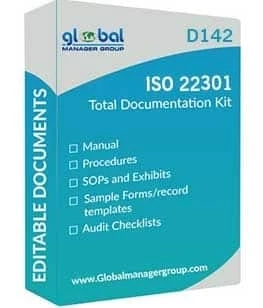In today\'s dynamic business environment, disruptions are inevitable. From cyberattacks to natural disasters, unforeseen events can cripple operations and impact revenue, reputation, and customer trust. This is where ISO 22301, the international standard for business continuity management (BCM), comes in. It provides a framework for organizations to build resilience and ensure business continuity through robust documentation.
As businesses confront an ever-changing landscape, the require for strong business continuity management has never been more critical. ISO 22301 documentation serves as the foundation for organizational resilience, providing a systematic approach to navigate disruptions and maintain continuity.
Why is ISO 22301 Documentation Important?
- Compliance and Certification: Effective documentation is crucial for demonstrating compliance with the ISO 22301 standard and achieving certification. This not only enhances your organization\'s credibility but also opens doors to new business opportunities.
- Clarity and Consistency: Clear and well-defined documentation ensures everyone in the organization understands their roles and responsibilities during disruptions. This eliminates confusion and promotes coordinated action.
- Improved Business Continuity: Documented procedures and plans provide a roadmap for responding to and recovering from disruptions effectively. This minimizes downtime and ensures critical operations continue.
- Enhanced Risk Management: By identifying and documenting potential threats, organizations can develop proactive mitigation strategies, reducing the impact of disruptions.
- Auditing and Improvement: Comprehensive documentation facilitates internal audits and external certification assessments, allowing for continuous improvement of the BCMS.
Key Elements of ISO 22301 Documentation:
- BCMS Policy: This outlines the organization\'s commitment to BCM and establishes the overall framework.
- Business Continuity Objectives: These define the acceptable downtime for critical processes and functions.
- Risk Assessments: Identify potential threats and their impact on business continuity.
- Business Continuity Plans (BCPs): Detailed plans for responding to and recovering from specific disruptions.
- Procedures: Define specific steps for various activities within the BCMS, such as incident response and communication.
- Records: Maintain documentation of audits, training, exercises, and incidents to demonstrate compliance and continuous improvement.
ISO 22301 procedures are the backbone of effective business continuity management, providing a detailed roadmap for organizations to follow during disruptions. By embedding these procedures into the fabric of operations, businesses not only enhance their resilience but also optimize their overall efficiency, creating a culture of preparedness that extends beyond compliance, and fostering operational excellence in the face of uncertainty.
ISO 22301 certification is more than a validation of compliance; it is a testament to an organization\'s commitment to continuity excellence. We explore the significance of achieving ISO 22301 certification, how it instills confidence among stakeholders, and the positive impact it can have on a business\'s reputation and market competitiveness.
Conclusion:
In conclusion, the importance of ISO 22301 documentation in modern businesses cannot be overstated. It is not merely a compliance requirement but a proactive approach to ensuring continuity in the face of disruptions. From identifying risks to crafting effective response procedures and achieving certification, ISO 22301 documentation becomes a strategic tool for businesses to thrive in an unpredictable world.



